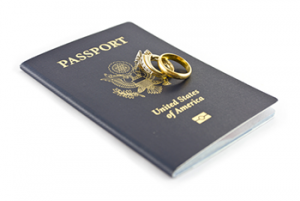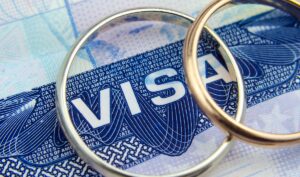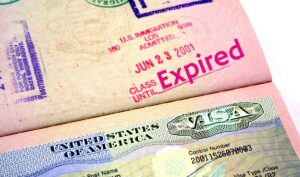
When a U.S. citizen marries a foreign citizen, there are fundamentally two different ways for the foreign citizen to immigrate to the United States and obtain a green card. The choice — a fiancé visa or marriage visa — can cause confusion for many couples. Each has its own benefits. So what’s best for one couple may not be ideal for another couple’s situation. In making your decision, you’ll need to consider speed of the process, cost, as well as other factors.
Fiancé Visa
The fiancé visa (aka K-1 visa) is a nonimmigrant visa obtained by the foreign fiancé to travel to the U.S. for the purpose of getting married in the U.S. and then adjusting status to a permanent resident (green card holder).
Marriage Visa
The marriage visa (aka CR-1 or IR-1 visa) is an immigrant visa obtained by the foreign spouse while in the foreign country after marriage for the purpose of immigrating to the U.S. to live permanently with the spouse.
Deciding on the fiancé visa or marriage visa is a personal decision. So, the best path for you depends on your specific situation. However, for many couples, the speed of the immigration process is an important factor.
Fiancé Visa (K-1 Visa)
The fiancé visa, formally known as a K-1 visa, is a method used for foreign citizens engaged to a U.S. citizen to enter the United States for the specific purpose of marrying that U.S. citizen. Once married, the foreign spouse must go through a process called “adjustment of status” if he or she wants to obtain a green card.
Fiancé Visa Process
The process begins with the U.S. citizen fiancé petitioning the U.S. government to grant a fiancé visa. The U.S. citizen must file Form I-129F, Petition for Alien Fiancé, with U.S. Citizenship and Immigration Services (USCIS). Once the petition is approved, a visa interview will be scheduled at the U.S. consulate office in the foreign fiancé’s country.
Next, the consulate will issue a fiancé visa if everything goes well in the interview. But you must use the visa to enter the United States within six months of its issuance, otherwise it will expire.
The K-1 is a nonimmigrant visa. That means it does not permit the immigrant to stay in the U.S. permanently. Its sole purpose is to allow the fiancé to enter for the purpose of marriage to a U.S. citizen.

Then, after entering the United States on your fiancé visa, you’ll need to get married, and start working on an adjustment of status (AOS) application. In fact, you must get married and file the adjustment of status application within 90 days of entering the U.S. If you meet some unexpected delays that prevent you from marrying and/or filing the AOS application, contact an immigration attorney.
Adjustment of Status
Adjustment of Status is the process that the foreign spouse uses to request a change in immigration status to that of a permanent resident. An immigrant who has successfully filed the Adjustment of Status Application is allowed to live legally in the United States while awaiting an interview at a USCIS office.
The adjustment of status packet generally includes several USCIS forms. In order to adjust status, you and your spouse will need to prepare and submit the following USCIS forms:
- I-485, Application to Register Permanent Residence or Adjust Status
- I-864, Affidavit of Support
- I-693, Report of Medical Examination and Vaccination Record
- I-765, Application for Employment Authorization (optional)
- I-131, Application for Travel Document (optional)
In addition to the forms, you’ll need to gather various documents to submit with the application package such as birth certificates, marriage certificate, and other supporting documents that prove you have a good faith marriage.
The next step in the process is an interview at your local USCIS office. After the interview, your green card will be mailed to your home address.
Plan Ahead
If you do not apply to adjust status within 90 days of the marriage, you will be required to leave the U.S. Your K-1 status will cease, and you will be in direct violation of the terms of your visa. If you stay beyond the terms of the visa, it will likely make the K-1 subject to deportation and negatively impact the fiancé’s ability to obtain permanent resident status in the future.
If you and your spouse plan to live in the U.S., a timely filing the adjustment of status packet is absolutely critical. Many couples prefer the adjustment of status process because you can go through the entire process of obtaining a green card from within the United States, provided that you’re already here on a legal basis, such as a valid fiancé visa.
Very few immigrants have the privilege of adjusting of status. As the spouse of a U.S. citizen, you qualify as an immediate relative that has this convenience.
RECOMMENDED: Overview of the K-1 Visa Process
Marriage Visa (CR-1 or IR-1)

A marriage visa can mean different things to different people. We’ll explain it as a method for a foreign citizen married to a U.S. citizen or permanent resident to enter the United States with an immigrant visa to live permanently in the U.S. as a permanent resident (green card holder).
In this case, the couple would have to get married outside the United States. Then, the process begins with the U.S. citizen or permanent resident petitioning the U.S. government to reserve a visa number for his or her spouse. The petitioner must file Form I-130, Petition for Alien Relative.
Consular Processing
This process called consular processing. Consular processing is the method that most immigrants will have to use in order to obtain a green card. With consular processing, the spouse waits outside the United States until the immigrant visa (permanent residence) is approved.
Once the petition is approved, the file will be sent to the National Visa Center (NVC). And after the NVC has completed its review, it will send the file to the U.S. consular office in the immigrant spouse’s country.
Consular Interview
At this point, the immigrant spouse will be scheduled for an interview at the U.S. consular offices. At the interview, a consular official will discuss the contents of your application with you, and verify that you’re not inadmissible for any reason. The official will also ask you questions about your marriage to make sure it is a genuine marriage, and not fraudulent in any way.
K-1 or CR-1/IR-1 Visa?
If you’re considering a marriage-based green card, there may be more than one option. Explore your paths to immigrate based on different factors.
EXPLORE NOWSpouse Visa (K-3 Visa)
In some cases the couple has been married and living abroad before they decided to move to the United States. They may wait together outside the U.S. while the immigrant visa is approved. But what if the U.S. citizen must return to the United States before his or her spouse has a green card? In this situation, the U.S. citizen may obtain a K-3 visa for the spouse. The K-3 visa is a nonimmigrant (temporary) visa that can be used by the immigrant spouse to come to the U.S. and then adjust status.
This starts with the U.S. citizen spouse filing Form I-130. Upon receiving the receipt notice, the U.S. citizen must file Form I-129F to request the K-3 visa.
RECOMMENDED: Marriage Green Card: Obtaining Permanent Residence through Marriage
Fiancé Visa or Immigrant Visa: The Best Choice
To determine which path is best for you — fiancé visa or immigrant visa — depends on many factors and is a personal decision. Here are several issues to consider:
Place of Marriage
The purpose of the K-1 fiance visa is to come to the U.S. for marriage. So if the couple desires to marry inside the United States, this is generally the best path. This method does require some planning. Again, the marriage and adjustment of status filing must take place in the U.S. within the 90 days of the K-1’s admission to the United States. If your preference is a marriage outside the United States, the K-1 visa probably is not the best option. Keep in mind: it is acceptable to have an unofficial wedding reception or religious ceremony that is not legally binding abroad then come to the U.S. to be legally married.
Speed of Marriage
If your priority is to become married as soon as possible, it will generally be quicker to marry outside the United States. Obtaining a K-1 visa, typically the fastest way to the U.S., will take approximately 5-10 months. So visiting the fiancé in his or her home country will usually be faster.
Speed of U.S. Presence
If the goal is for the couple to be together in the U.S. as soon as possible, the K-1 visa is most likely the fast path. From the date of filing to the date of admission to the U.S., it will take approximately 5-10 months on a K-1 fiancé visa. On the other hand, the marriage visa may take 10-16 months. However, if the U.S. citizen spouse resides abroad, it may be even faster to request the immigrant visa by filing the I-130 with a USCIS international office.
Filing Fees
Each path requires slightly different forms/applications with various costs. If costs are a major concern, obtaining the marriage visa (CR1 or IR1) will generally be less expensive.
K-1 Non-Immigrant Visa
| Expense Item | Cost (USD) |
| Filing Fee for Form I-129F | $535 |
| Filing Fee for K-1 Visa Application | $265 |
| Medical Exam | $200 |
| Filing Fees for Adjustment of Status Package and Biometrics | $1,225 |
| Medical Exam (vaccination form only) | $100 |
| ESTIMATED TOTAL | $2,325 |
CR-1 or IR-1 Immigrant Visa
| Expense Item | Cost (USD) |
| Filing Fee for Form I-130 | $535 |
| Filing Fee for Immigrant Visa Application | $325 |
| NVC I-864 review fee (if applicable) | $120 |
| Medical Exam | $200 |
| USCIS Immigrant Fee | $220 |
| ESTIMATED TOTAL | $1,400 |
These figures are estimates based on USCIS filing fees at the time this article was published. Estimates do not include any travel or hotel that may be required for appointments and/or interviews. Immigration medical exam fees are estimated and may vary by region and doctor.
International Travel
If the immigrant fiancé travels often, this factor should be considered when deciding between the fiancé visa or marriage visa path. A K-1 visa is valid for a single entry. International travel is not permitted until the foreign spouse files a Form I-485, Application to Adjust Status, along with an Application for Advance Parole (Form I-131). Advance parole is generally issued within 90 days of filing. If the foreign spouse travels abroad before an advance parole document is obtained, the adjustment of status application will be considered abandoned. But a CR-1 or IR-1 spouse that entered the U.S. with an immigrant visa can travel abroad immediately. An immigrant visa holder is a permanent resident upon admission to the U.S. Additionally, the K-3 visa facilitates international travel. It can be used for multiple entries to the U.S. and is valid for up to two years.
Fiancé Visa or Marriage Visa
These are just a few of the issues that a couple must evaluate when deciding on the fiancé visa or marriage visa. For many immigrant couples, speed is an important consideration, especially given the long wait times that are often involved with the immigration process. Before you begin, check the USCIS processing times for each petition. Many immigrants will be able to choose between several options for how to get into the country. Which one you’ll want depends primarily on your particular needs and wants, as well as the current wait times that you’ll encounter.
About CitizenPath
CitizenPath provides simple, affordable, step-by-step guidance through USCIS immigration applications. Individuals, attorneys and non-profits use the service on desktop or mobile device to prepare immigration forms accurately, avoiding costly delays. CitizenPath allows users to try the service for free and provides a 100% money-back guarantee that USCIS will approve the application or petition. We provide support for the Petition for Alien Fiancé (Form I-129F), Petition to Help a Relative Obtain a Green Card (Form I-130), Application to Adjust Status (Form I-485), and several other USCIS forms.
Note to Reader: This post was originally published on July 31, 2018, and has been modified with improvements.
Want more immigration tips and how-to information for your family?
Sign up for CitizenPath’s FREE immigration newsletter and
SAVE 10%
on our immigration services



